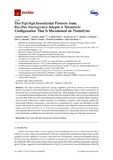Mostrar el registro sencillo del ítem
The Vip3Ag4 insecticidal protoxin from bacillus thuringiensis adopts a tetrameric configuration that is maintained on proteolysis
| dc.creator | Palma Dovis, Leopoldo | es_ES |
| dc.creator | Scott, David J. | es_ES |
| dc.creator | Harris, Gemma | es_ES |
| dc.creator | Din, Salah-Ud | es_ES |
| dc.creator | Williams, Thomas L. | es_ES |
| dc.creator | Roberts, Oliver J. | es_ES |
| dc.creator | Young, Mark T. | es_ES |
| dc.creator | Caballero Murillo, Primitivo | es_ES |
| dc.creator | Berry, Colin | es_ES |
| dc.date.accessioned | 2017-11-15T08:00:45Z | |
| dc.date.available | 2017-11-15T08:00:45Z | |
| dc.date.issued | 2017 | |
| dc.identifier.issn | 2072-6651 (Electronic) | |
| dc.identifier.uri | https://hdl.handle.net/2454/26151 | |
| dc.description.abstract | The Vip3 proteins produced during vegetative growth by strains of the bacterium Bacillus thuringiensis show insecticidal activity against lepidopteran insects with a mechanism of action that may involve pore formation and apoptosis. These proteins are promising supplements to our arsenal of insecticidal proteins, but the molecular details of their activity are not understood. As a first step in the structural characterisation of these proteins, we have analysed their secondary structure and resolved the surface topology of a tetrameric complex of the Vip3Ag4 protein by transmission electron microscopy. Sites sensitive to proteolysis by trypsin are identified and the trypsin-cleaved protein appears to retain a similar structure as an octomeric complex comprising four copies each of the ~65 kDa and ~21 kDa products of proteolysis. This processed form of the toxin may represent the active toxin. The quality and monodispersity of the protein produced in this study make Vip3Ag4 a candidate for more detailed structural analysis using cryo-electron microscopy. | en |
| dc.description.sponsorship | The authors would like to thank the International Research Support Initiative Program Fellowship, Higher Education Commission of Pakistan for support to SUD. DJS is a Senior Molecular Biology and eutron Fellow supported by the Science and Technology Facilities Council (UK). GH is funded by the Medical Research Council (UK). Analytical services in the School of Chemistry, Cardiff University, were funded by EPSRC Grant number EP/L027240/1. Open access publishing was funded by Cardiff University. | en |
| dc.format.extent | 11 p. | |
| dc.format.mimetype | application/pdf | en |
| dc.language.iso | eng | en |
| dc.publisher | MDPI | en |
| dc.relation.ispartof | Toxins, 2017, 9(5), 165 | en |
| dc.rights | © 2017 by the authors; licensee MDPI, Basel, Switzerland. This article is an open access article distributed under the terms and conditions of the Creative Commons Attribution (CC BY) license. | en |
| dc.rights.uri | http://creativecommons.org/licenses/by/4.0/ | |
| dc.subject | Vip3 toxin | en |
| dc.subject | Electron microscopy | en |
| dc.subject | Surface topology | en |
| dc.title | The Vip3Ag4 insecticidal protoxin from bacillus thuringiensis adopts a tetrameric configuration that is maintained on proteolysis | en |
| dc.type | Artículo / Artikulua | es |
| dc.type | info:eu-repo/semantics/article | en |
| dc.contributor.department | IdAB. Instituto de Agrobiotecnología / Agrobioteknologiako Institutua | es |
| dc.rights.accessRights | Acceso abierto / Sarbide irekia | es |
| dc.rights.accessRights | info:eu-repo/semantics/openAccess | en |
| dc.identifier.doi | 10.3390/toxins9050165 | |
| dc.relation.publisherversion | https://dx.doi.org/10.3390/toxins9050165 | |
| dc.type.version | Versión publicada / Argitaratu den bertsioa | es |
| dc.type.version | info:eu-repo/semantics/publishedVersion | en |



